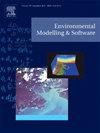PyTorchFire:一个gpu加速的野火模拟器,带有可微分元胞自动机
IF 4.8
2区 环境科学与生态学
Q1 COMPUTER SCIENCE, INTERDISCIPLINARY APPLICATIONS
引用次数: 0
摘要
准确和快速预测野火趋势对有效管理和减灾至关重要。然而,火灾传播的随机性对开发可靠的模拟器提出了重大挑战。在本文中,我们介绍了PyTorchFire,这是一个开放访问的、基于pytorch的软件,它利用了GPU加速。通过我们重新设计的可微分野火细胞自动机(CA)模型,我们实现了毫秒级的计算效率,在高分辨率的真实世界火灾中显著优于传统的基于cpu的野火模拟器。通过对我们的模型进行梯度下降,实时参数校准成为可能,使模拟与观测到的野火行为在时间和空间上紧密一致,从而增强了模拟的真实感。与监督学习代理模型相比,我们的PyTorchFire模拟器与现实世界的环境数据相结合,展示了优越的泛化能力。其实时预测和校准野火行为的能力确保了准确性、稳定性和效率。PyTorchFire有可能彻底改变野火模拟,作为野火预测和管理的强大工具。本文章由计算机程序翻译,如有差异,请以英文原文为准。
PyTorchFire: A GPU-accelerated wildfire simulator with Differentiable Cellular Automata
Accurate and rapid prediction of wildfire trends is crucial for effective management and mitigation. However, the stochastic nature of fire propagation poses significant challenges in developing reliable simulators. In this paper, we introduce PyTorchFire, an open-access, PyTorch-based software that leverages GPU acceleration. With our redesigned differentiable wildfire Cellular Automata (CA) model, we achieve millisecond-level computational efficiency, significantly outperforming traditional CPU-based wildfire simulators on real-world-scale fires at high resolution. Real-time parameter calibration is made possible through gradient descent on our model, aligning simulations closely with observed wildfire behavior both temporally and spatially, thereby enhancing the realism of the simulations. Our PyTorchFire simulator, combined with real-world environmental data, demonstrates superior generalizability compared to supervised learning surrogate models. Its ability to predict and calibrate wildfire behavior in real-time ensures accuracy, stability, and efficiency. PyTorchFire has the potential to revolutionize wildfire simulation, serving as a powerful tool for wildfire prediction and management.
求助全文
通过发布文献求助,成功后即可免费获取论文全文。
去求助
来源期刊

Environmental Modelling & Software
工程技术-工程:环境
CiteScore
9.30
自引率
8.20%
发文量
241
审稿时长
60 days
期刊介绍:
Environmental Modelling & Software publishes contributions, in the form of research articles, reviews and short communications, on recent advances in environmental modelling and/or software. The aim is to improve our capacity to represent, understand, predict or manage the behaviour of environmental systems at all practical scales, and to communicate those improvements to a wide scientific and professional audience.
 求助内容:
求助内容: 应助结果提醒方式:
应助结果提醒方式:


